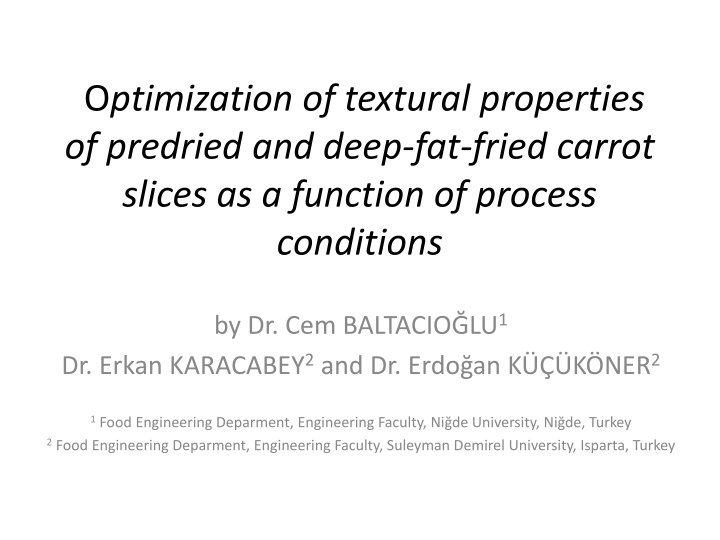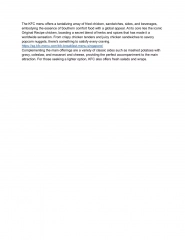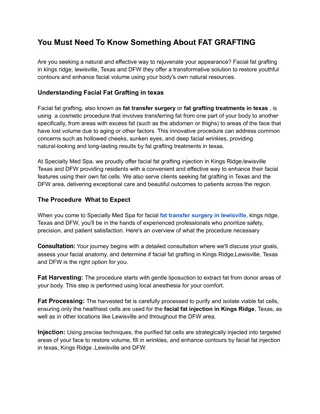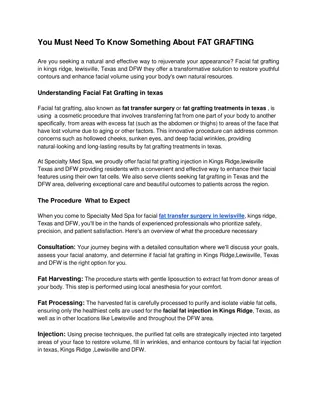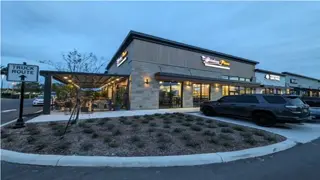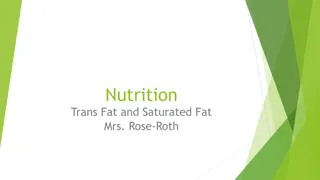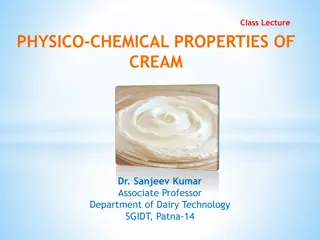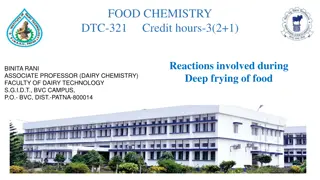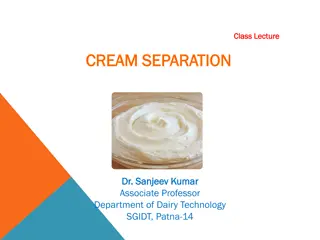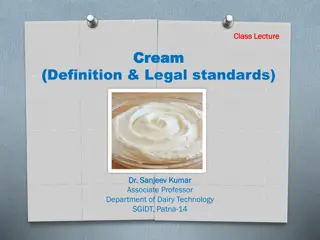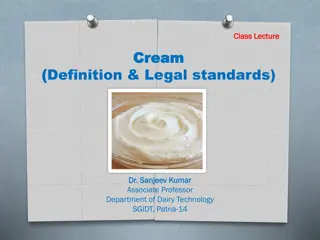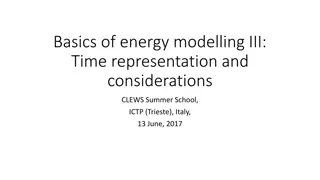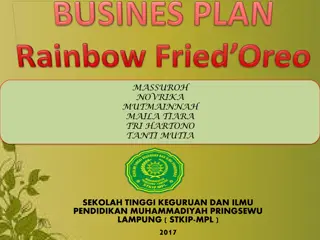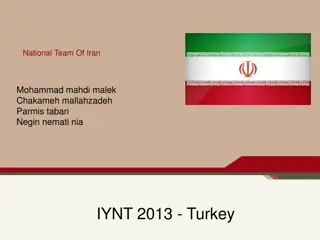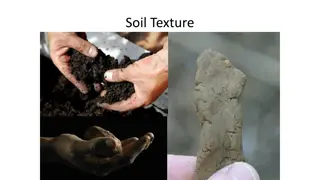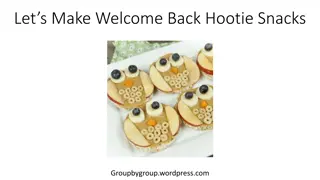Optimization of Textural Properties of Predried and Deep-Fat-Fried Carrot Slices
This study explores the optimization of textural properties of carrot slices through predrying and deep-fat frying processes. Factors affecting texture, oil absorption, and moisture content are analyzed, with a focus on consumer expectations and product quality.
Download Presentation

Please find below an Image/Link to download the presentation.
The content on the website is provided AS IS for your information and personal use only. It may not be sold, licensed, or shared on other websites without obtaining consent from the author.If you encounter any issues during the download, it is possible that the publisher has removed the file from their server.
You are allowed to download the files provided on this website for personal or commercial use, subject to the condition that they are used lawfully. All files are the property of their respective owners.
The content on the website is provided AS IS for your information and personal use only. It may not be sold, licensed, or shared on other websites without obtaining consent from the author.
E N D
Presentation Transcript
Optimization of textural properties of predried and deep-fat-fried carrot slices as a function of process conditions by Dr. Cem BALTACIO LU1 Dr. Erkan KARACABEY2and Dr. Erdo an K K NER2 1Food Engineering Deparment, Engineering Faculty, Ni de University, Ni de, Turkey 2Food Engineering Deparment, Engineering Faculty, Suleyman Demirel University, Isparta, Turkey
Outline Introduction to Deep-Fat-Frying Aim What we did What we obtained Let s Discuss it Conclusion
Deep-Fat-Frying Popular cooking method Especially for vegetables Carrot Frying Using vegetable oil At high temperature levels For certain time
Deep-Fat-Frying What is going on during deep-fat-frying? Type of dehydration process including simultaneous heat and mass transfer Rapid temperature raise Water molecules evaporate Increasing internal pressure of frying material Decreasing moisture content Case hardening Crust formation depending on frying material
Deep-Fat-Frying Important points for evaluation of deep-fat- fried products Oil uptake Moisture content Textural properties Taste, flavor, aroma Surface color Shape, size etc.
Deep-Fat-Frying Textural properties should meet the consumer expectations Texture is significant and determinative characteristic for fried products for consumer s perception Vary depending on type of product
Deep-Fat-Frying Factors affecting textural properties of final fried product Raw material Type Composition Preprocess Boiling Drying Other possible applications
Deep-Fat-Frying Main project was about the control of oil absorption of fried carrot slices. As a pretreatment, drying was performed to decrease the moisture content of carrot slices There is a relation between initial moisture content of frying material and its final oil content. Less moisture content resulted in limited oil absorption.
Deep-Fat-Frying As a pretreatment, Conventional oven drying Microwave oven drying To decrease the moisture content of carrot slices
Deep-Fat-Frying Factors affecting textural properties of final fried product Frying process Oil temperature Process time Frying material/Oil volume (w/v)
Outline Introduction to Deep-Fat-Frying Aim What we did What we obtained Let s Discuss it Conclusion
Aim of the study Main purpose of the current study as a part of main project was To evaluate the change of textural properties of deep-fat-fried product , initial moisture content was lowered by two different drying methods (conventional oven and microwave oven). To optimize the predrying and deep-fat-frying process conditions in terms of textural properties
Outline Introduction to Deep-Fat-Frying Aim What we did What we obtained Let s Discuss it Conclusion
Material & Methods Carrots were purchased from local producer s orchard to avoid changes due to carrot type and environmental-climatic variations. Stored @ +4oC Before process washed peeled sliced (slice thickness selected according to preliminary studies to determine consumer demands towards conventionally fried carrot slices) boiled for 90 sec in boiling water (~ 100oC) (enough for enzyme inactivation)
How was carrot slice predried and fried? Predrying Conventional oven Constant air flow (around 0.8 m/sec) temperature is adjustable (from 50oC to 300oC) Microwave oven Temperature is adjustable (from 30oC to 100oC) Deep-fat-frying Industrial fryer Temperature is adjustable (from 50oC to 200oC)
Experimental Design For optimization experimental design should be created using different tools including statistical based ones For conventional predrying & frying Central Composite Design 4 independent variables at 5 levels with 4 central points For microwave predrying & frying Full Factorial Design 3 independent variables at 3 levels
Coded & Real Values of Independent Variables of Conventionally Predrying & Deep-Fat-Frying Independent Variable Real/Coded Values of Variables Drying Temperature (oC) 41 / -2 48 / -1 55 / 0 62 / 1 69/ 2 Weight Loss (%) 10 / -2 12.5 / -1 15 / 0 17.5 / 1 20 / 2 Frying Temperature (oC) 120 / -2 135 / -1 160/ 0 165 / 1 180 / 2 Frying Time (sec) 120 / -2 240 / -1 360 / 0 480 / 1 600 / 2
Experimental Design of Conventional Predrying & Deep-Fat-Frying Run Order 1 2 3 4 5 6 7 8 9 10 11 12 13 14 15 16 17 18 19 20 21 22 23 24 25 26 27 28 Drying Temperature -1 1 1 0 0 0 1 -1 0 -1 -2 2 -1 -1 0 0 -1 0 1 1 -1 -1 1 0 1 0 1 0 Weight Loss -1 -1 -1 0 0 0 1 1 0 1 0 0 -1 1 0 -2 1 2 -1 1 -1 -1 1 0 1 0 -1 0 Frying Temperature 1 -1 1 2 0 0 -1 1 0 -1 0 0 1 -1 -2 0 1 0 -1 1 -1 -1 1 0 -1 0 1 0 Frying Time 1 1 1 0 -2 0 1 -1 0 -1 0 0 -1 1 0 0 1 0 -1 1 1 -1 -1 2 -1 0 -1 0
Coded & Real Values of Independent Variables of Predrying Using Microwave oven & Deep-Fat-Frying Independent Variable Real/Coded Values of Variables Weight Loss (%) in Microwave Oven 10/ -1 15/ 0 20/ 1 Frying Temperature (oC) 140 / -1 160/ 0 180 / 1 Frying Time (sec) 200 / -1 350 / 0 500 / 1
Experimental Design of Microwave Predrying & Deep-Fat-Frying Run Order 1 2 3 4 5 6 7 8 9 10 11 12 13 14 15 16 17 18 19 20 21 22 23 24 25 26 27 Weight Loss Frying Temperature Frying Time 0 1 1 1 0 0 1 0 0 0 1 0 1 1 0 1 -1 1 1 -1 1 1 0 -1 0 0 -1 0 -1 1 1 -1 1 1 0 -1 -1 0 -1 -1 -1 0 0 1 0 1 1 -1 1 -1 1 0 0 -1 -1 1 0 -1 0 -1 -1 -1 0 0 1 1 -1 0 -1 1 0 -1 1 1 -1 -1 -1 0 0 -1 -1
Textural Properties Predried and Fried Carrot Slices were subjected to texture analysis. TPA Analysis (cylindirical prob-30 mm diameter) hardness elasticity cohesiveness chewiness Cutting Hardness (LKB prob) cutting hardness
Optimization Statistical method Response Surface Methodology Minitab Statistical Package Program Full Quadratic Model For conventional drying and frying = = 1 1 i i 4 4 1 2 3 4 = i = i j = i = i j = + + + + 2 i Z X X X X X X 0 i i ii ij i j ij i j + + 1 1 3 1 For microwave drying and frying = 1 i 3 3 2 3 = i = i = i j = + + + 2 i Z X X X X 0 i i ii ij i j + 1 2 1
Outline Introduction to Deep-Fat-Frying Aim What we did What we obtained Let s Discuss it Conclusion
Textural properties measured for conventionally predried and fried carrot slices Hardness, g force 1 494.10 7.25 2 491.29 8.98 3 747.02 7.35 4 420.07 3.72 5 2055.64 16.47 6 492.18 4.49 7 836.92 6.53 8 637.78 8.46 9 374.93 4.13 10 1254.31 10.80 11 1029.35 3.60 12 697.35 9.11 13 1003.17 10.94 14 1142.03 8.58 15 2605.95 4.34 16 699.12 7.43 17 605.08 2.98 18 301.12 3.00 19 2105.69 18.18 20 648.90 5.00 21 1883.51 4.20 22 2871.82 12.67 23 1204.07 8.37 24 597.44 6.68 25 1248.08 16.20 26 132.02 0.00 27 770.65 14.45 28 1050.38 4.18 Cutting force, g force 418.42 762.95 871.39 401.29 1137.52 662.77 638.08 785.44 1065.72 925.73 1041.91 941.92 736.27 667.85 855.06 1236.99 907.23 888.83 1513.50 413.10 950.37 1056.23 1017.36 585.70 1228.83 689.77 992.32 846.08 Chewiness Run Order Elasticity Cohesiveness 0.77 0.35 0.35 0.16 0.85 0.33 0.69 0.50 0.17 0.53 0.17 0.34 0.70 0.50 0.85 0.51 0.13 0.10 0.87 0.16 0.84 0.85 0.51 0.61 0.70 0.30 0.85 0.39 2746.34 5223.12 7401.48 2519.88 29136.72 2001.03 11768.32 4370.96 3159.75 16388.11 4554.69 6673.15 9427.18 3288.18 15615.83 4980.77 3662.58 2300.00 33048.78 2950.00 3196.26 30828.77 9090.02 5957.69 21379.64 1990.00 8535.15 2376.30
Developed models and corresponding performance parameters of conventionally predried and fried carrot slice s textural properties Model coefficients Model Sabiti Etiketi intercept DTemp WL FTemp FTim DTemp*Dte mp WL*WL FTemp*Ftem p FTim*Ftim Dtemp*WL FTemp*FTim Regression R2 R2adj Lack-of-fit *, p 0.05; **, p 0.01; ***,p 0.001,ns: statistically non-significant DTemp: Drying temperature (oC), WL: Weight loss (%), FTemp: Frying temperature (oC), FTim: Frying time (sec) Cutting force, g force Chewiness Hardness, g force Elasticity Cohesiveness coefficient p-value coefficient p-value coefficient p-value coefficient p-value coefficient p-value ns 512.38 -208.60 -298.84 -841.22 -596.93 * ns 3.20 2.52 -2.17 -1.88 -5.73 * * * ns 0.30 0.00 -0.22 -0.23 -0.18 ** ns 2381.77 2477.09 -2739.23 -8594.12 -11599.20 816.09 65.83 -117.84 -209.13 -310.83 *** ns ns ns ns ns ** ** * *** ** *** *** * *** *** ns ns ns ns 398.15 4.91 * 0.05 4474.96 163.60 ns ns ns ns ns 34.92 3.78 0.10 2501.42 234.60 ns ns 1047.81 ** 2.59 0.30 * 7928.90 * -200.13 ns 861.34 609.18 501.39 * ns 10.14 -2.15 2.48 *** 0.52 0.29 -0.15 *** 16408.25 2367.04 15876.63 *** 90.4 84.7 ** *** 33.30 -241.94 195.95 ns ns ns ns ns ns ns ns *** *** 78.6 66.0 ns *** 82.1 71.6 ns *** 75.5 61.1 ns ** 70.1 52.5 ns
Optimal process conditions for desired values of corresponding responses of conventionally dried and fried carrot slices Drying Temp Weight Loss Frying Temp Frying Time Cutting force Chewiness Cohesiveness Elasticity Hardness
Textural properties measured for predried in microwave oven and fried carrot slices Hardness, g force 1 1101.22 18.63 2 169.63 0.86 3 461.42 12.87 4 138.97 1.79 5 559.64 3.29 6 444.34 5.01 7 163.89 2.07 8 2294.74 8.45 9 611.27 8.12 10 771.65 4.30 11 176.15 6.96 12 70.92 3.12 13 1382.92 9.01 14 1314.98 16.32 15 2322.30 12.34 16 548.87 6.12 17 1074.70 11.87 18 1088.61 16.10 19 171.18 2.98 20 748.40 5.57 21 1414.92 9.75 22 1040.12 4.12 23 1637.41 18.55 24 2257.98 10.10 25 896.79 16.07 26 2558.09 10.61 27 3537.92 5.60 Cutting force, g force 896.39 1035.09 776.04 466.35 783.24 713.91 928.47 1566.36 723.34 1123.72 369.84 819.33 1571.29 935.99 1949.03 493.61 1058.99 2050.40 1365.27 958.91 1716.83 1182.99 1411.81 1118.68 1073.59 2126.19 1926.10 Chewiness Run Order Elasticity Cohesiveness 0.67 0.28 0.54 0.43 0.38 0.28 0.17 0.83 0.26 0.26 0.39 0.47 0.83 0.65 0.88 0.44 0.68 0.66 0.37 0.65 0.53 0.34 0.86 0.86 0.67 0.69 0.89 17980.71 57.62 7185.23 37.61 2125.79 6841.00 134.72 17203.22 5055.00 2229.00 4106.00 100.09 7893.84 16307.72 12394.11 5892.00 11387.37 12929.68 225.24 9155.67 17158.30 5559.23 26248.23 17042.78 13331.84 23273.52 13044.46
Developed models and corresponding performance parameters of predried in microwave oven and fried carrot slice s textural properties Model coefficients Model Sabiti Etiketi intercept Cutting force, g force Chewiness Hardness, g force Elasticity Cohesiveness coefficient p-value coefficient p-value coefficient p-value coefficient p-value coefficient p-value 831.71 -308.71 16.6182 -0.6032 *** 0.611766 15062.0 -3444.8 771.916 -51.993 * *** *** *** - *** *** ns ns ns WL 0.024588 -438.211 -1.2822 - -2533.1 -23.013 *** *** ** ns ns FTemp 0.176086 -807.187 -3.4305 - -6326.1 -460.049 *** *** *** *** *** FTim 0.161492 186.000 -3.7132 - -2373.2 23.389 ** ns ns ns ns WL*WL 0.018118 55.496 -3.9997 - -3993.0 222.179 FTemp*Ftem p FTim*Ftim FTemp*FTim Regression R2 R2adj Lack-of-fit ** * * * ns 0.087511 ** 0.020801 ns0.031397 *** 85.4 80.1 ns 119.777 311.419 *** 90.96 87.55 ns -4.4039 -0.8048 *** 74.5 65.2 ns -2065.7 -330.8 326.656 104.885 *** 78.7 70.8 ns ** ns ns ** ns ns ns ns *** 82.9 76.6 ns *, p 0.05; **, p 0.01; ***,p 0.001, ns: statistically non-significant WL: Weight loss (%), FTemp: Frying temperature (oC), FTim: Frying time (sec)
Optimal process conditions for desired values of corresponding responses of dried in microwave oven and fried carrot slices Weight Loss Frying Temp Frying Time Cutting force Chewiness Cohesiveness Elasticity Hardness
Outline Introduction to Deep-Fat-Frying Aim What we did What we obtained Let s Discuss it Conclusion
Kurutma Scakl, C 55 A rl k Kayb , % Weight loss, 15% Drying temperature, 55oC 15 4500 hardness, g force 30 00 Sertlik, g k u v v e t 1 5 0 0 00 12 2 2 0 4 1 0 6 180 frying temperature, oC K z a r t m a S cakl , C 1 2 0 2 0 0 60 0 zartma S resi, sn frying time, sec K Figure 1. Change of hardness of carrot slices conventionally predried and fried under effects of frying temperature and time Kurutma S cakl , C 55 A rl k Kayb , % Weight loss, 15% Drying temperature, 55oC 15 20 elasticity astikiyet l E 10 00 6 12 0 1 1 0 2 1 8 0 50 1 frying time, sec z K a r m t S a s , i s e r n 180 180 240 210 zart K frying temperature, oC ma S l k a c C , Figure 2. Change of elasticity of carrot slices conventionally predried and fried under effects of frying temperature and time
Drying temperature, 55oC Kurutma S cakl , C 55 A rl k Kayb , % Weight loss, 15% 15 1 5 . cohesiveness 1. 0 Kohezyon 1 1 0 2 5 . 0 5 5 1 1 5 5 0 0 0 K frying temperature, oC zartma S cakl , C 1 0 8 60 12 120 12 a S resi, sn m frying time, sec 0 2 2 1 1 0 0 1 1 8 8 0 0 0 0 2 4 0 z K t r a Figure 3. Change of cohesiveness of carrot slices conventionally predried and fried under effects of frying temperature and time Drying temperature, 55oC Kurutma S cakl , C 55 A rl k Kayb , % Weight loss, 15% 15 600 0 0 0 chewiness Cignenebili rlik 40000 40000 0 0 2 0 0 0 0 0 1 120 1 5 0 K frying temperature, oC 0 1 0 8 z t r a m a c S l k a , C 60 120 120 0 1 0 1 0 8 8 2 2 2 1 1 1 0 0 2 4 0 K zartma S resi, sn frying time, sec Figure 4. Change of chewiness of carrot slices conventionally predried and fried under effects of frying temperature and time
Kurutma Scakl, C 55 A rl k Kayb , % Weight loss, 15% Drying temperature, 55oC 15 cutting force, 1 2 2 0 5 5 100 000 100 000 g force 7 5 5 0 K e s m e i l t r e S g kuvvet , i g 50 00 60 60 1 2 0 0 1 2 0 50 1 180 180 z K frying time, sec t r a m a S r s , i s e n 240 240 21 21 0 0 K zartma S c l k a C , frying temperature, oC Figure 5. Change of cutting force of carrot slices conventionally predried and fried under effects of frying temperature and time
Arlk Kayb, % 15 Weight loss, 15% 2 000 hardness, g force S ertlik, k g t e v v u 1 0 00 1 1 0 4 1 0 1 60 60 6 1 2 0 z K t r a frying time, sec m a S cakl , C 1 0 1 0 8 8 1 1 8 8 0 0 2 4 4 0 K zartma S resi, sn frying temperature, oC Figure 6. Change of hardness of carrot slices predried in a microwave and fried under effects of frying temperature and time A rl k Kayb , % 15 Weight loss, 15% 1 5 astikiyet l E elasticity 10 5 6 0 20 1 0 180 8 180 z K frying temperature, oC t r a m a S , i s e r sn 1 0 6 1 0 6 2 2 4 4 0 0 1 1 4 0 K zartma frying time, sec c S l k a C , Figure 7. Change of elasticity of carrot slices predried in a microwave and fried under effects of frying temperature and time
Arlk Kayb, % 15 Weight loss, 15% 8 . 0 Kohez yon cohesiveness 0 6 . 0 6 . 0. 4 0 .2 140 60 1 0 6 120 180 180 K S cak a m t r a z frying temperature, oC , l C 180 240 0 K zartma S resi, sn frying time, sec Figure 8. Change of cohesiveness of carrot slices predried in a microwave and fried under effects of frying temperature and time A rl k Kayb , % 15 Weight loss, 15% 2 0 0 0 0 0 0 1 1 k 0 0 0 0 0 0 0 0 0 0 0 0 chewiness i i l r i l i b e n e n 0 0 6 0 0 1 0 4 40 1 2 0 180 1 6 0 K t r a z frying time, sec m S a resi, sn 240 240 1 1 180 180 K frying temperature, oC t r a z m S a cakl , C Figure 9. Change of chewiness of carrot slices predried in a microwave and fried under effects of frying temperature and time
Arlk Kayb, % 15 Weight loss, 15% 20 0 0 0 0 0 0 0 cutting force, g kuvvet , i g force K e s m e i l t r e S 50 1 500 1 0 000 50 500 1 1 0 4 4 0 0 60 1 2 0 1 1 1 60 1 8 0 K zartma c S l k a C , 1 0 8 frying temperature, oC 240 240 z K frying time, sec t r a m a S r s , i s e n Figure 10. Change of cutting force of carrot slices predried in a microwave and fried under effects of frying temperature and time
Outline Introduction to Deep-Fat-Frying Aim What we did What we obtained Let s Discuss it Conclusion
It could be suggested that Partial drying before frying is important pretreatment in terms of food characteristics. Texture is one of them and mainly affected by frying conditions and partially predrying ones. Weight loss is the main factor affecting textural properties of carrot slices during predrying carried according to both drying method in case of the range of parameters studied. Studied parameters ranges were not severe to modify textural properties of carrot slices, but its partial effects on moisture content directly affects further frying process, so indirectly textural properties.
Acknowledgements Current study was financially supported by TUBITAK (Project No: 113R015).
